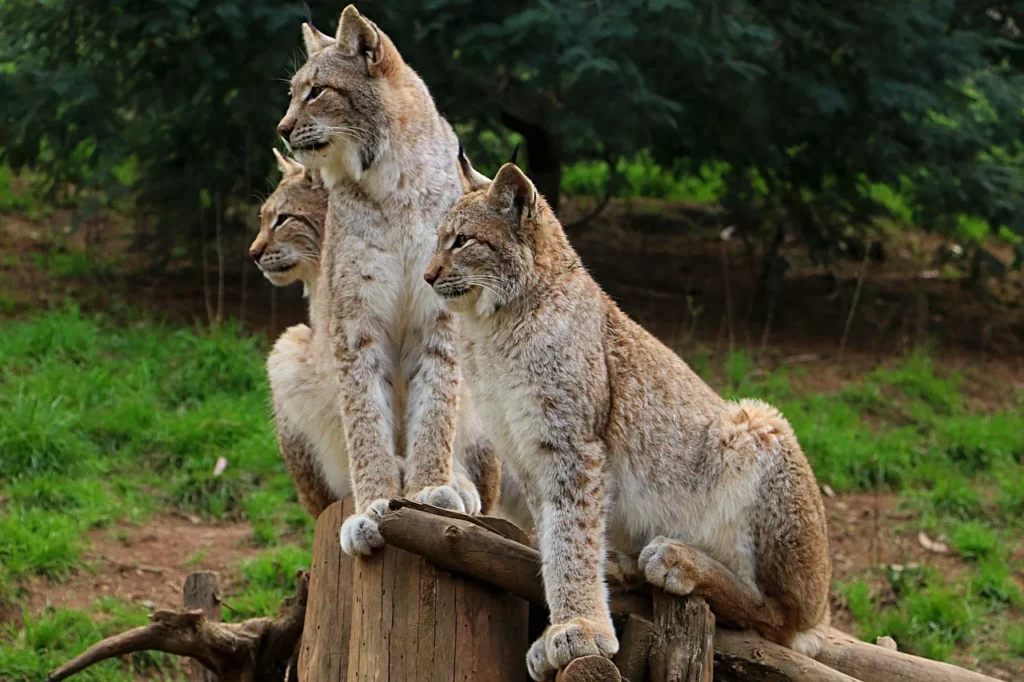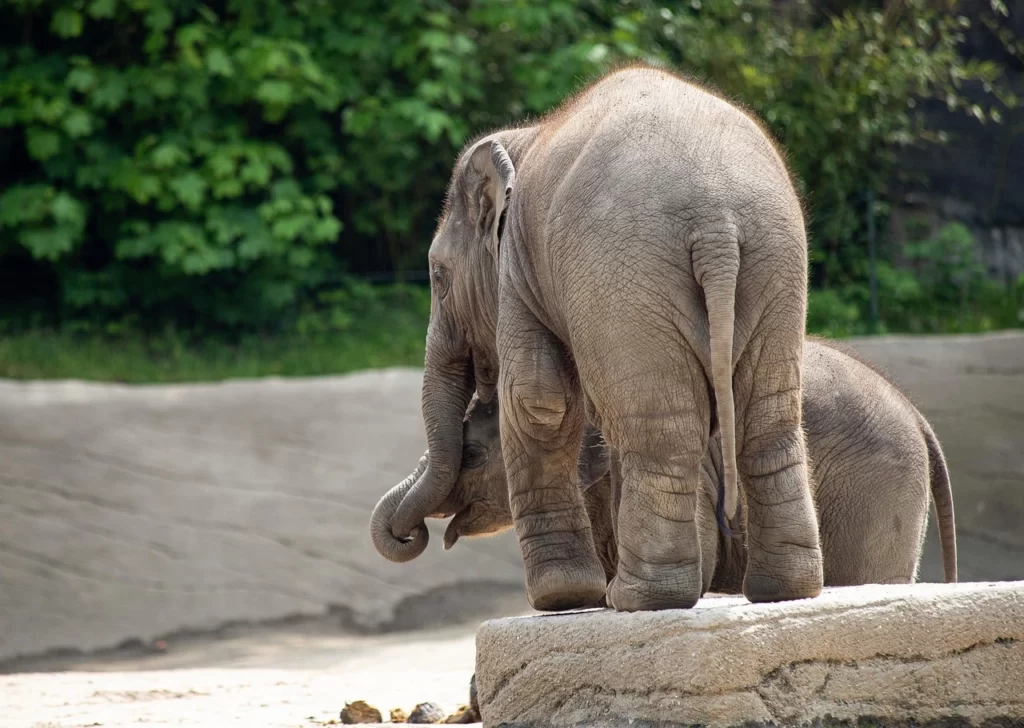The most popular animals in zoos
Elephants
Elephants are the largest land animals in the world. There are two main species: the African elephant and the Asian elephant. You can find them in zoos such as the Guadalajara Zoo and the Madrid Zoo. These gentle giants are known for their intelligence and strong family bonds. Don’t forget to check them out when you visit a zoo!
Giraffes
Giraffes are the tallest creatures in the world and live mainly in Africa. With their long necks and unique spots, giraffes are easy to recognize. They are very social and curious animals, and they often enjoy interacting with zoo visitors.
Lions
The king of the jungle, the lion, is another popular animal that you can find in zoos. Lions live in groups called prides, which are led by a dominant male and several lionesses. Lions are known for their mane and powerful roar. If you’re lucky, you might hear a lion’s roar during your visit to the zoo.
Bears
Bears are large and powerful animals that live in a variety of habitats around the world. There are many different species of bears, such as the brown bear, the polar bear, and the panda bear. Bears are known for their love of honey and their ability to sleep for long periods, especially during the winter.
Tigers
Tigers are the largest felines in the world and live in Asia. They are solitary hunters and are endangered due to habitat loss and poaching. Tigers are known for their stripes and their ability to swim.
Did you know? Koalas have fingerprints so similar to humans that they can even be confused at a crime scene. Click To TweetAnimal habitats in the zoo
The African savannah
In the zoo, you will find habitats that mimic the African savannah, home to animals like elephants, giraffes, and lions. This habitat recreates the conditions of the savannah, with open spaces, scattered trees, and tall grasses. The animals of the African savannah are known for being adaptable and surviving in an environment with limited resources. Watch how they interact and live in harmony!
The rainforest
Zoos also recreate the rainforest habitat to house animals like tigers, monkeys, and colorful birds. The rainforest is a humid, warm, and full-of-life place, with a great variety of plants and animals. In this environment, you can see how animals climb trees, hide among plants, and adapt to an ever-changing environment.
Polar regions
Some animals in the zoo come from the cold polar regions of the world, such as polar bears, penguins, and walruses. These sites recreate these icy conditions so that these animals feel at home. Get ready to feel the cold while visiting this exciting habitat!
Underwater life
Zoos also have sections dedicated to underwater life, where you can see animals like sharks, sea turtles, and colorful fish. In these aquariums, you can learn about the oceans and the animals that inhabit them. Don’t forget to take a break and enjoy the underwater views!
Examples of animals that live in a zoo
- African Elephant
- Asian Elephant
- Giraffe
- Lion
- Brown Bear
- Polar Bear
- Panda Bear
- Bengal Tiger
- Siberian Tiger
- Mountain Gorilla
- Chimpanzee
- Orangutan
- Lemur
- Gray Wolf
- Iberian Wolf
- Kangaroo
- Koala
- Cougar
- Jaguar
- White Rhinoceros
- Black Rhinoceros
- Hippopotamus
- Nile Crocodile
- American Crocodile
- Caiman
- Meerkat
- Porcupine
- Armadillo
- Giant Otter
- Sloth
- Howler Monkey
- Squirrel Monkey
- Iguana
- Chameleon
- Boa Constrictor
- Reticulated Python
- Rhea
- Ostrich
- Emu
- Flamingo
- Bald Eagle
- Andean Condor
- Toucan
- Parrot
- Macaw
- Emperor Penguin
- Humboldt Penguin
- Seal
- Sea Lion
- Walrus
- Dolphin
- Orca
- Galápagos Tortoise
- Loggerhead Turtle
- Clownfish
- Hammerhead Shark
- Lionfish
- Jellyfish
- Octopus
- Seahorse
- Zebra
- Wildebeest
- African Buffalo
- Antelope
- Okapi
- Gazelle
- Tapir
- Capybara
- Peccary
- King Snake
- Tarantula
- Gharial
- Iberian Lynx
- Siamang
- Golden Lion Tamarin
These are just a few examples of animals that you can find in zoos around the world. There are many more species, but this list gives you an idea of the diversity of animals that can be seen in a zoo.
Did you know? Octopuses have three hearts and their blood is blue due to the presence of hemocyanin, a copper-based oxygen-carrying pigment, instead of the iron-based hemoglobin found in humans. Click To TweetConservation and Education in Zoos
Protecting Endangered Animals
Zoos play an important role in the conservation of endangered species. Through breeding and reintroduction programs, zoos work to increase the populations of threatened animals and protect them from disappearing forever. Supporting zoos is an excellent way to help conserve wildlife!

Education and Awareness
Visiting a zoo is an excellent opportunity to learn about animals and their habitats. Zoos offer educational programs, talks, and activities to teach visitors about the importance of protecting our natural world. Take advantage of these opportunities to learn and share your knowledge with others!
Tips for a Fun and Educational Zoo Visit
Here are some tips to ensure your zoo visit is exciting and educational:
- Plan Your Visit: Check the zoo map and decide which animals and habitats you would like to see. This will help you make the most of your time at the zoo.
- Attend Talks and Demonstrations: Learn from the experts and discover interesting facts about animals by attending talks and demonstrations at the zoo. These activities are a great way to learn about wildlife and conservation.
- Observe Animal Behavior: Take time to observe how animals interact with each other and their environment. This will give you a better understanding of how they live and behave in their natural habitat.
- Read Signs and Information Panels: Zoos often have signs and information panels near animal habitats. Make sure to read them to learn interesting facts and how you can help protect these species.
- Respect Zoo Rules: Do not feed the animals or cross safety barriers. These rules are designed to protect both the animals and visitors.
Be Part of the Solution!
Support Zoos and Conservation
Visiting and supporting zoos is an important way to contribute to wildlife conservation. By purchasing tickets, souvenirs, and making donations, you can help fund conservation and education programs that protect animals and their habitats.
Become a Wildlife Ambassador
After visiting the zoo, share your experiences and what you learned with your friends and family. By talking about the importance of wildlife conservation, you can inspire others to take action to protect our natural world.
Small Actions Make a Big Difference
Here are some actions you can take to make a difference for wildlife:
- Recycle and reduce plastic use to decrease pollution in the oceans and protect marine animals.
- Buy sustainable and fair-trade products to support habitat conservation and local communities.
- Participate in beach, park, and natural area clean-up events to keep our environments clean and healthy.
- Support conservation organizations and research projects to protect animals and their habitats.
Frequently Asked Questions
A zoo is a place where animals are kept in enclosures designed to mimic their natural habitats, while on a safari, visitors can see animals in their natural environment or in large open areas that simulate wildlife.
Zoos participate in breeding programs, research, and reintroduction of endangered species, as well as educating the public about the importance of conservation and how they can contribute to protecting animals and their habitats.
No, you should not feed the animals in the zoo. Animals have specific and carefully controlled diets, and feeding them food outside of their diet can be harmful to their health
Zoos use environmental enrichment, which includes toys, activities, and elements that challenge animals mentally and physically, encouraging natural behaviors and keeping them active and healthy.
Zoos offer educational programs, talks, and interactive activities to teach visitors about animals, their habitats, conservation, and how they can contribute to protecting the environment and endangered species.
The number of animals in a zoo varies depending on the size and facilities of the zoo. Some zoos may have hundreds of animals, while larger ones may house thousands of animals of various species.
ome examples of endangered animals that can be found in zoos include the giant panda, Bengal tiger, Asian elephant, mountain gorilla, and black rhinoceros.
Some common birds in zoos include flamingos, toucans, macaws, parrots, bald eagles, Andean condors, penguins, ostriches, emus, and rheas.
The diet of animals in the zoo varies by species. Caretakers provide specific and balanced diets for each animal, which can include fruits, vegetables, grains, insects, meat, fish, and specialized food.
The world’s largest zoo in terms of the number of species and land size is the San Diego Zoo, located in San Diego, California, USA.
Zoos offer benefits in terms of species conservation, research, public education, and raising awareness about wildlife and the importance of protecting their habitats.
Advantages of zoos include conservation, research, and education about wildlife. Disadvantages can include confinement of animals in limited spaces, the stress they may experience, and the possibility that zoo conditions do not fully represent their natural habitat.
Animals in zoos are kept in captivity for several reasons, such as species conservation, scientific research, and public education. Some animals may have been rescued and are not suitable to be released into the wild, while others may be part of breeding programs to increase the population of their species.
By visiting a zoo, you can explore different habitats, learn about endangered animals, and discover how you can make a difference in wildlife conservation. Always remember to have fun and learn while visiting the exciting world of zoo animals!


